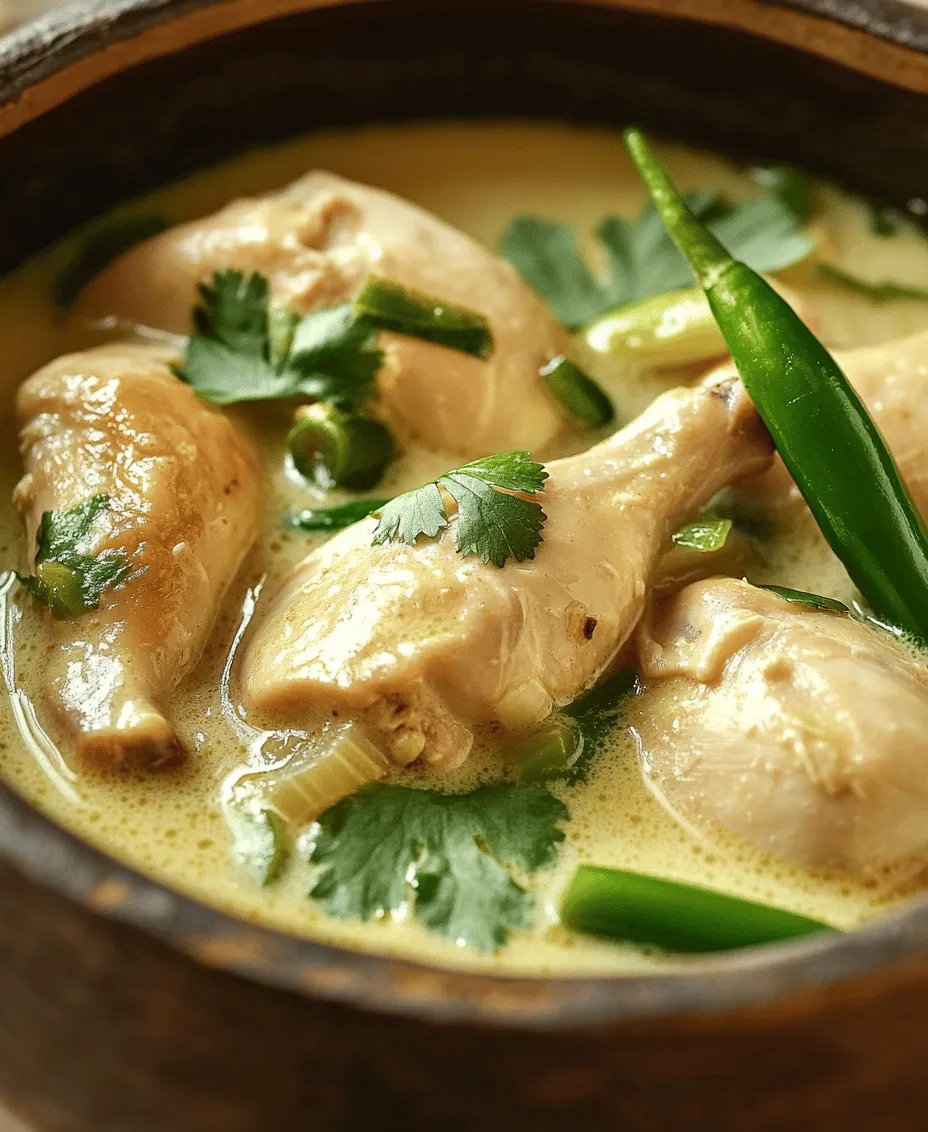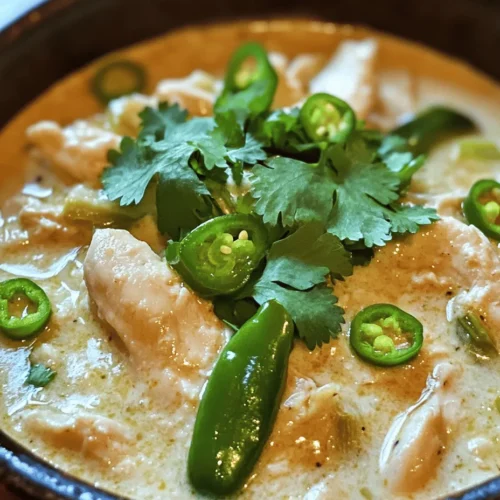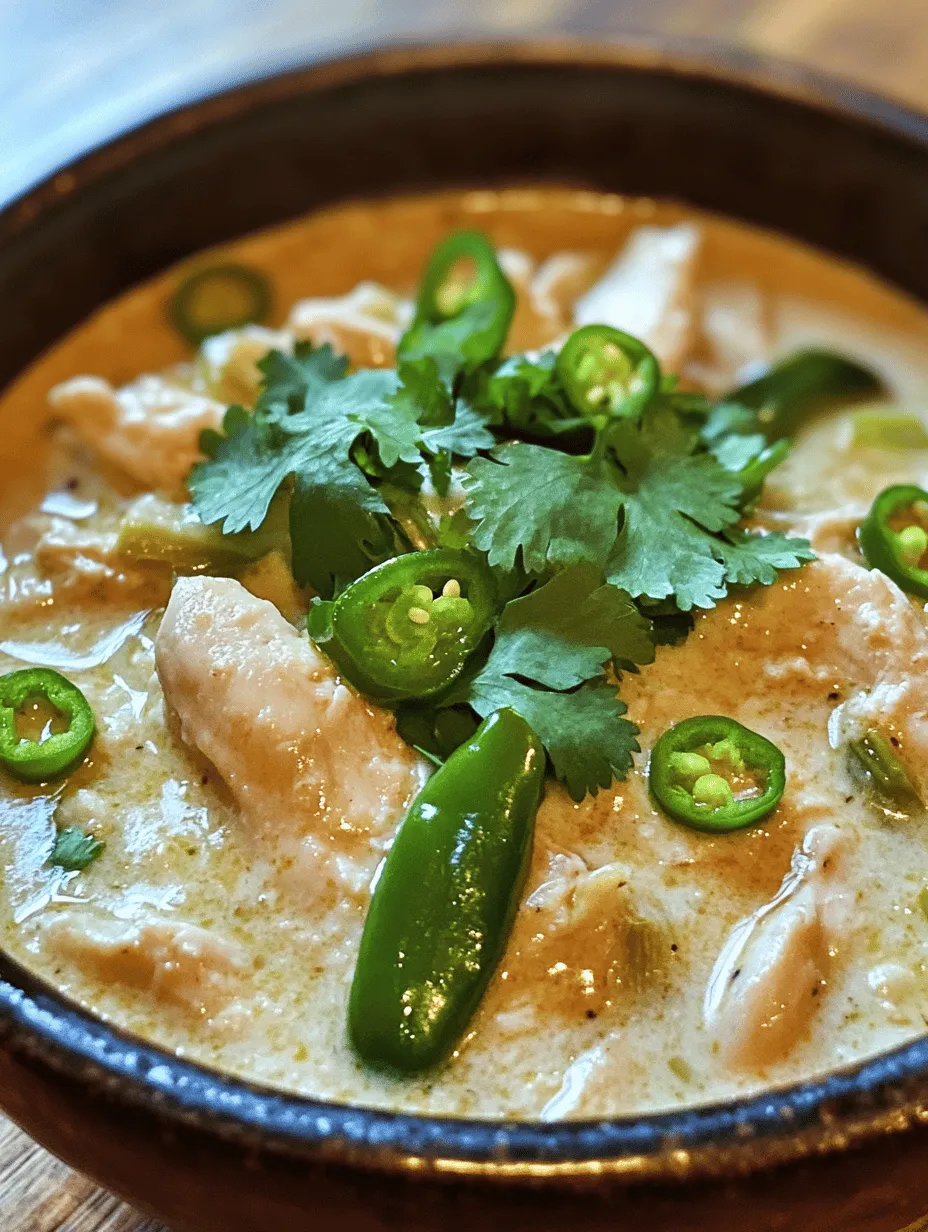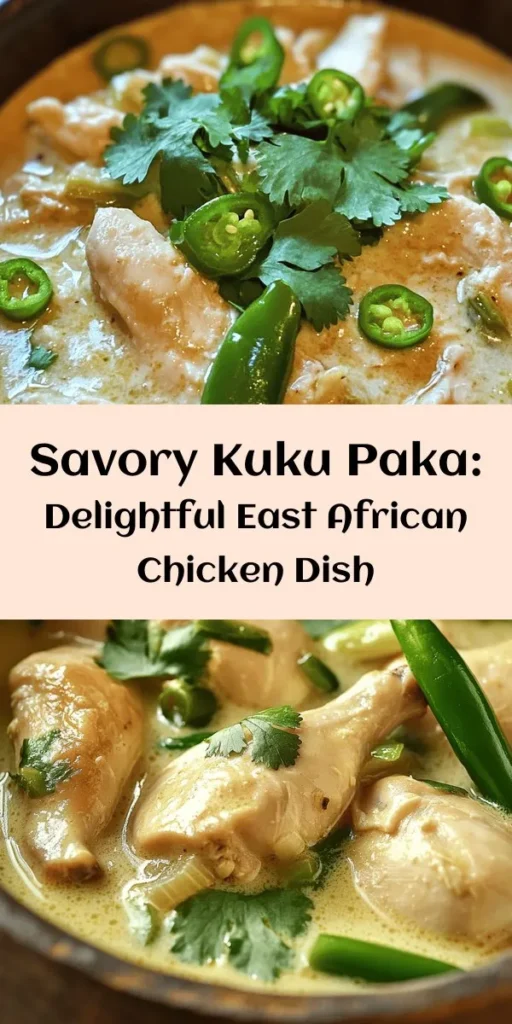Introduction
Kuku Paka is a delightful and aromatic chicken dish that hails from the coastal regions of East Africa, particularly Kenya and Tanzania. This traditional recipe beautifully showcases the rich culinary heritage of the region, combining the essence of fresh ingredients with the complex flavors derived from a unique blend of spices and coconut milk. The name “Kuku Paka” translates to “chicken in coconut,” perfectly encapsulating its star ingredient and the dish’s comforting essence.
Coconut milk plays a pivotal role in East African cuisine, adding a creamy texture and a subtle sweetness that enhances the overall flavor profile of dishes. It is often combined with an array of spices, including curry powder, coriander, and cumin, which not only elevate the taste but also reflect the cultural fusion that characterizes East African cooking. The influence of Indian cuisine, brought by traders and settlers over centuries, has woven its way into the fabric of local food traditions, giving rise to dishes like Kuku Paka that are loved by many.
As you embark on this culinary journey, you will discover the rich tapestry of flavors, textures, and cultural significance that comes with Kuku Paka. It is more than just a meal; it is a celebration of community and togetherness, often served during gatherings, family feasts, and festive occasions. Get ready to explore the delicious world of Kuku Paka and learn how to prepare this exquisite dish that will transport your taste buds to the sun-kissed shores of East Africa.
The Origins of Kuku Paka
To truly appreciate Kuku Paka, one must understand its origins and the historical influences that shaped it. The dish is a wonderful representation of the melting pot of cultures that East Africa embodies. It draws heavily from the Swahili people, who have long inhabited the coastal regions of Kenya and Tanzania, and who have incorporated spices and cooking techniques from various cultures, including Indian, Arab, and Portuguese influences.
Historically, Kuku Paka emerged as a dish that was not only enjoyed by locals but also by visitors and traders who passed through the bustling ports of the region. The use of coconut milk can be traced back to the coastal areas where coconuts are abundant, and the blending of spices reflects the interactions between different cultures over centuries. This fusion of culinary traditions has made Kuku Paka a beloved staple, often associated with celebrations and communal meals.
In East African households, Kuku Paka is more than just a dish; it symbolizes hospitality and togetherness. It is commonly prepared during special occasions such as weddings, religious celebrations, and family gatherings, where the act of sharing food serves to strengthen bonds among family and friends. The communal nature of enjoying Kuku Paka highlights its significance in the East African culinary landscape, making it a dish that is cherished by many.
Ingredients Breakdown
When preparing Kuku Paka, the quality and freshness of the ingredients are paramount to achieving an authentic taste. Here’s a detailed overview of the key ingredients that contribute to this flavorful dish:
Whole Chicken
The star of Kuku Paka is undoubtedly the chicken. Using a whole, fresh chicken not only ensures maximum flavor but also allows for even cooking and proper marination. The chicken should be cleaned and cut into pieces, allowing the spices to penetrate and infuse the meat. Opting for free-range or organic chicken can enhance the dish’s taste, providing a richer flavor profile that complements the coconut milk and spices beautifully.
Coconut Milk
Coconut milk is the heart of Kuku Paka, lending a creamy texture and a naturally sweet flavor that balances the spices. It is packed with nutritional benefits, including healthy fats, vitamins, and minerals that promote heart health and provide a good source of energy. When selecting coconut milk, it is best to choose high-quality, natural options without additives to ensure the purest flavor. The creamy consistency of coconut milk will meld perfectly with the spices, creating a luscious sauce that coats the chicken beautifully.
Spices
The spices used in Kuku Paka play a crucial role in building the dish’s flavor complexity. Key spices include:
– Curry Powder: This blend of spices adds warmth and depth to the dish. It typically contains ingredients such as turmeric, cumin, and coriander, which all contribute to the vibrant color and taste of the Kuku Paka.
– Coriander: Ground coriander provides a citrusy flavor that complements the richness of coconut milk and the savory notes of the chicken.
– Cumin: Known for its earthy and slightly nutty flavor, cumin enhances the overall spice profile of the dish and adds a layer of warmth.
Fresh Herbs and Aromatics
In addition to spices, fresh herbs and aromatics elevate Kuku Paka’s flavor and aroma. The following ingredients are essential:
– Ginger: Fresh ginger adds a zesty kick and aromatic warmth that enhances the dish’s overall flavor.
– Garlic: Garlic is a staple in many cuisines and brings a punch of flavor that pairs well with the chicken and spices.
– Cilantro: Fresh cilantro adds a refreshing note to the dish, balancing the richness of the coconut milk and spices.
Using fresh herbs and aromatics not only enhances the taste but also contributes to the dish’s aromatic profile, making each bite a sensory delight.
Preparation Steps
Creating Kuku Paka is a rewarding culinary experience that involves several key steps to ensure the flavors meld beautifully. Here’s a detailed guide to preparing this delicious dish:
Step 1: Marinating the Chicken
The first step in preparing Kuku Paka is to marinate the chicken. This step is crucial for enhancing the flavor and tenderness of the meat.
1. Clean the Chicken: Rinse the chicken pieces under cold water and pat them dry with paper towels. This ensures that any impurities are removed.
2. Prepare the Marinade: In a large bowl, combine the curry powder, ground coriander, ground cumin, minced ginger, minced garlic, and a pinch of salt. Mix well to create a paste.
3. Coat the Chicken: Rub the spice paste thoroughly over the chicken pieces, ensuring an even coating. This allows the flavors to penetrate the meat.
4. Rest the Chicken: Cover the bowl with plastic wrap or a lid and let the chicken marinate for at least 1 hour in the refrigerator. For the best results, marinate overnight to allow the flavors to deepen.
Step 2: Sautéing Aromatics
Once the chicken is marinated, it’s time to sauté the aromatics, which will serve as the flavor foundation for Kuku Paka.
1. Heat Oil: In a large, heavy-bottomed pot or Dutch oven, heat a few tablespoons of cooking oil (such as vegetable or coconut oil) over medium heat until shimmering.
2. Add Aromatics: Add finely chopped onions to the pot and sauté until they become translucent and fragrant, about 5-7 minutes. This step builds the aromatic base for the dish.
3. Incorporate Ginger and Garlic: Add minced ginger and garlic, stirring continuously to prevent burning. Cook for an additional 2-3 minutes until the mixture is aromatic.
Step 3: Cooking the Chicken
After the aromatics have been sautéed, it’s time to cook the marinated chicken.
1. Brown the Chicken: Increase the heat to medium-high and add the marinated chicken pieces to the pot. Sear the chicken on all sides until golden brown, approximately 5-10 minutes. This step creates a flavorful crust and locks in moisture.
2. Deglaze the Pot: If any bits are stuck to the bottom of the pot, you can deglaze it by adding a splash of water or broth, scraping the bottom to lift the flavorful bits.
Step 4: Incorporating Spices and Tomatoes
Once the chicken is browned, it’s time to deepen the flavors further by incorporating spices and tomatoes.
1. Add More Spices: Sprinkle in additional curry powder, coriander, and cumin to enhance the flavor profile.
2. Tomatoes: Add chopped tomatoes (fresh or canned) to the pot, stirring well to combine. The acidity from the tomatoes balances the richness of the coconut milk, adding depth to the sauce.
Step 5: Adding Coconut Milk
The final step in preparing Kuku Paka involves creating the creamy sauce that ties all the flavors together.
1. Pour in Coconut Milk: Once the tomatoes have softened, pour in the coconut milk, stirring to combine. The creamy texture will envelop the chicken, creating a luscious sauce.
2. Simmer: Bring the mixture to a gentle simmer, cover the pot, and let it cook for about 30-40 minutes, or until the chicken is cooked through and tender. Stir occasionally to prevent sticking and ensure an even distribution of flavors.
By following these preparation steps, you will be well on your way to creating a delicious and authentic Kuku Paka that embodies the vibrant culinary heritage of East Africa. The combination of fresh ingredients, aromatic spices, and the creamy richness of coconut milk will make this dish a standout at any gathering. Prepare to impress your family and friends with this truly remarkable culinary experience.

Final Seasoning Adjustments: Importance of Taste and Texture
As you near the completion of your Kuku Paka, it’s crucial to refine the flavors that will elevate this dish from good to unforgettable. Taste is paramount, and the balance between the spices, the creaminess of the coconut milk, and the tenderness of the chicken should be harmonious. After simmering, take a moment to taste your dish and consider the following adjustments:
1. Salt and Pepper: Start with a small pinch of salt and black pepper. Taste again after mixing; the right seasoning enhances flavors without overpowering.
2. Acidity: A splash of lime juice can brighten the dish, cutting through the richness of the coconut milk and adding a refreshing twist.
3. Sweetness: If desired, a hint of brown sugar or honey can balance out the spices, especially if your blend is particularly robust.
4. Herbs and Spices: Adjust the freshness by adding more cilantro or basil right before serving. A sprinkle of garam masala can also add depth without overwhelming the dish.
Serving Suggestions
Traditional Accompaniments for Kuku Paka
Kuku Paka is not just a dish; it’s a celebration of flavor and community, often enjoyed with various traditional accompaniments that complement its rich taste. Here are some classic pairings:
– Rice: Steamed basmati or jasmine rice absorbs the delicious coconut sauce, making for a satisfying meal.
– Chapati: Soft, flaky chapati is perfect for scooping up the chicken and sauce. Its mild flavor pairs beautifully with the spices in Kuku Paka.
– Ugali: This staple of East African cuisine, made from maize flour, is another excellent choice. Its neutral taste allows the flavors of Kuku Paka to shine.
Serving Style: Family-Style vs. Individual Plating
Kuku Paka is often served family-style, where a large pot is placed at the center of the table, allowing everyone to serve themselves. This encourages sharing and enhances the communal dining experience, which is central to East African culture. Alternatively, for a more formal occasion, consider individual plating. Serve each portion with a generous ladle of sauce, ensuring that each plate is garnished beautifully.
Garnishing Ideas: Enhancing Presentation with Fresh Herbs
Presentation is key in making a dish visually appealing. For Kuku Paka, consider the following garnishes:
– Fresh Cilantro or Parsley: Chopped finely and sprinkled over the dish adds a vibrant green contrast.
– Lime Wedges: Serve alongside for an extra dash of brightness.
– Sliced Chilis: For those who enjoy heat, a few slices can enhance both appearance and flavor.
Nutritional Information
Understanding the nutritional profile of Kuku Paka gives insight into its health benefits and how it fits into a balanced diet. Per serving, Kuku Paka typically contains:
– Calories: Approximately 400-500 calories, depending on portion size and specific ingredients used.
– Macronutrients:
– Protein: Chicken provides a substantial amount of lean protein necessary for muscle repair and growth.
– Carbohydrates: If served with rice or ugali, you get a good source of carbohydrates for energy.
– Fats: Coconut milk contributes healthy fats, which support brain health and provide long-lasting energy.
Health Benefits of Coconut Milk and Spices Used in the Recipe
Coconut milk is not just a delicious ingredient; it also offers numerous health benefits. Rich in lauric acid, it has antimicrobial properties that can support the immune system. The spices commonly used in Kuku Paka, such as turmeric and ginger, are known for their anti-inflammatory properties and can aid digestion.
How Kuku Paka Fits into a Balanced Diet
Kuku Paka can fit seamlessly into a balanced diet when paired with vegetables and whole grains. By serving it with a side of steamed vegetables or a fresh salad, you increase the fiber content of your meal, promoting better digestion and overall health.
Cultural Significance of Kuku Paka
Kuku Paka holds a special place in East African culture, often appearing at family gatherings and celebrations. It is a dish that echoes the communal spirit of dining together, reflecting the diversity of East African cuisine.
Role of Kuku Paka in East African Family Meals and Celebrations
In many East African households, Kuku Paka is a staple for special occasions such as weddings, holidays, and family reunions. It brings people together, fostering connections through shared experiences and flavors. The act of cooking and serving this dish becomes a ritual of love and hospitality, emphasizing the importance of family ties.
Stories or Anecdotes About Communal Dining Experiences
Many families have fond memories associated with Kuku Paka, whether it’s gathering around a large pot with loved ones or sharing hearty laughs and stories over a meal. These communal dining experiences not only nourish the body but also the spirit, creating a sense of belonging and community.
How Kuku Paka Reflects the Diversity of East African Culture
Kuku Paka is a perfect representation of the rich tapestry of cultures found in East Africa. The dish incorporates elements from various culinary traditions, showcasing the region’s diversity. Each family may have their unique twist on the recipe, representing their heritage and personal preferences, further enriching the story of Kuku Paka.
Variations of Kuku Paka
Kuku Paka is a versatile dish that can be adapted in numerous ways to suit different tastes and dietary preferences.
Exploring Regional Adaptations of Kuku Paka
Across East Africa, Kuku Paka may differ based on local ingredients and traditions. Some regions might add more heat with different chili varieties, while others may incorporate unique spices that reflect local flavors.
Vegetarian Options: Substitutes for Chicken
For those preferring vegetarian options, Kuku Paka can be easily adapted by substituting chicken with tofu, chickpeas, or even vegetables like cauliflower and bell peppers. These alternatives absorb the delicious coconut sauce beautifully, making for a satisfying meal.
Different Spice Blends and Ingredients for Personalizing the Dish
Consider experimenting with different spice blends such as curry powder or harissa to give your Kuku Paka a distinctive twist. Each variation can bring out new flavors and aromas, making the dish exciting each time you prepare it.
Popular Adaptations in Modern Kitchens
In modern kitchens, Kuku Paka has found its way into various culinary styles. Chefs often incorporate contemporary techniques, such as sous-vide cooking for the chicken, to enhance tenderness while staying true to the dish’s traditional roots.
Conclusion
Kuku Paka is a culinary gem that encapsulates the rich flavors and cultural heritage of East Africa. Its ability to bring people together, whether during everyday meals or special occasions, highlights the importance of food in fostering connections.
As you explore the recipe and its variations, take the opportunity to make it your own. Experiment with flavors, share it with loved ones, and create your own stories around this delightful dish. The joy of cooking Kuku Paka lies not just in the ingredients but in the experiences and memories you create while enjoying it with others.



